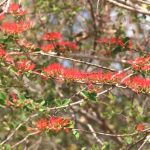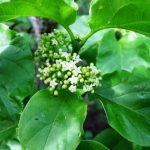TREE LIFE
April 1983
MASHONALAND CALENDAR
Tuesday April 5th : Botanic Garden Walk. Meet in the car park at 1645 for 1700 hours.
Sunday April 17th : Caledonia Farm, Ruwa, which is the farm of Bob and Val Laing. We found an interesting spot along a stream offering mixed bag of riverine and woodland species including Rhamnus prinoides and Bequartiodendron magalismontanum. Also a well vegetated hill near the homestead and a woodland area near a dam which appears worth exploring.
A bus has been arranged and will leave the Monomatapa Car Park at 0900 hours. Fare $5.00
BOTANIC GARDEN WALK, 1ST FEBRUARY 1983
The Chairman is at present doing a stint of work in Bulawayo. I would like to thank Kim Damstra for attending the Botanic Garden Walk and sending in the following notes :
An interesting postscript to last month’s examination of the Combretums occurred when we found a scrambling species in the botany garden at the University. The choice fell between C. celastroides and C. padoides but the fruit was too old and leaf characters too uncertain to confirm either. It was then we found a cream yellow flower and saw the real difference between these two species : in C. celastroides which we saw in flower last month, the style and anthers arise from a smooth floral disc, whereas in this specimen the floral disc of each flower was furry, a positive identification of C. padoides.
This month we started looking at the gardenia and coffee family, the RUBICACEAE. This family is easy to recognize as all species have simple leaves occurring in opposite pairs with two stipules on the branch between the leaf stalks or petioles. Just to illustrate this feature we began by examining the exotic tree Bertclavia nyasica, a rare tree from Southern Malawi near the Shire Valley. None of us could fail to notice the enormous interpetiolar stipules –almost 7cm long. The large simple leaves are a shiny green colour. The RUBIACEAE have a worldwide distribution, although in temperate regions they are usually shrubs. In equatorial forests the family is represented by enormous trees; here in Zimbabwe it is one of our larger families where most species are smaller trees.
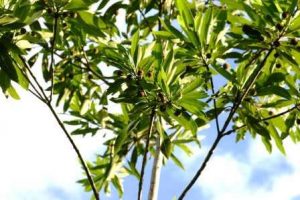
Breonadia microcephala. Photo: Bart Wursten. Source: Flora of Zimbabwe
One tree I would really like to see in the field is Breonadia microcephala, but seeing it ‘in captivity’ (to adopt Lol Irvine’s terminology) is the next best. In Manicaland Breonadia grows into a handsome 30m riverine tree. The long (12 – 24 cm) lanceolate leaves tend to be bunched at the end of the branches and so the stipules, which fall early anyhow, are not easily seen. The leaves can easily be confused with Rauvolfia caffra which we examined later by way of comparison. It has been stated that the veins on the leaves of Rauvolfia are translucent, whereas in Breonadia they are opaque. In the gardens both species have translucent veins. But Rauvolfia, because it is of the APOCYANACEAE or oleander family, has a milky white sap not found in the RUBIACEAE. The heavy timber of Breonadia is so durable that old railway sleepers, now being replaced with cement sleepers, are still in excellent condition and can be re-utilized. This particular specimen was covered in balls of small, sweetly scented mauve flowers.
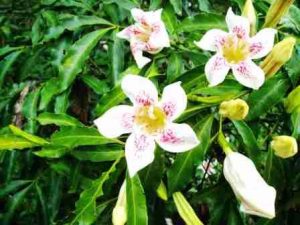
Rothmannia manganjae flowers. Photo: Mark Hyde. Source: Flora of Zimbabwe
As the RUBIACEAE is a large family Tom Muller wanted us to get the feel of the different genera, so we turned our attention to Rothmannia manganjae, a bush we have seen with creamy cuplike flowers during previous walks. The leaves of Rothmannia often appear to be in threes, but this is an interesting artifact where the axillary bud of one of the pair of opposite leaves has developed, but instead of growing into a branch it just produces one odd leaf. The small interpetiolar stipules were visible. The tree was adorned with green fruit the size of a squash ball as well as dried brown fruit. This exceptionally long ripening time is characteristic of Rothmannia, although in nature the monkeys plunder the ripe fruit before it begins to dry. This species is confined to evergreen forest margins in the eastern highlands.
The genus Tricalysia is presently under revision but the small leaved T. jasminiflora has characteristic flower buds along the branch as well as thread like interpetiolar stipules. Botanists are notorious for using obscure terminology but an interesting feature I only started to notice once I had learned the name was a ‘decussate’ arrangement for opposite leaves where each pair of leaves comes out from the branch at right angles to the pair below it. This neat arrangement is thought to avoid shading. We saw the ‘opposite decussate’ arrangement in the thorns of Combretum imberbe last month; it often reoccurs in the RUBIACEAE and can be seen in Tricalysia jasminiflora which occurs in the lower Lundi river area and from Mt. Selinda downwards where the south east rains fall in winter and so the vegetation approaches as an evergreen forest. Tricalysia is also common in Natal coastal forests as an evergreen understory below a deciduous canopy – rather an unusual arrangement.
Getting the ‘feel’ of a genus is sometimes difficult to describe. We know that if we hold the leaf of a Pavetta up to the light we see numerous black dots inside the leaf and yet after a while we have already recognized the plant before doing the ‘black dot’ test. These black dots are bacterial nodules that fix the nitrogen in the air by changing it into a form that the plant can use. Legumes often have similar bacteria that live in nodules of the root, but most plants in the garden need to be fed nitrogen by means of compost or an expensive fertilizer. Pavetta gracillima has elegant leaves where the leaf blade extends all the way down the leaf stalk. This tree is rather rare, on the route from Mt. Selinda to the Sabi and also occurs in the lower Mazowe Valley. The interpetiolar stipules may be a better feature for separating the species of different RUBIACEAE than the leaves. To illustrate this, we compared the thin stipules of P. gracillima with the broad based stipules of the common woodland P. gardinifolia that we often see on our walks.
Canthium is a big genus with distinctly decussate leaves and branches. One liane of the genus, C. enricianum had to be untied from a nearby tree in order to examine a branch. The side branches on the main stalk are confusingly similar to compound leaves and are used in climbing and support. The simple leaves in Canthium are usually a shiny green. A bit later we saw C. gurnsii, a very powerful hanging rope that is the most common liane in the Inyanga and Haroni-Rusitu rain forests. Once again the branches bend backwards and help in climbing. A little way behind C. gurnsii was a small specimen of C. vulgare, a rare and scattered tree from Mt. Selinda to Malawi. This plant can grow into a huge tree and is one of the few trees in the forest with fissured bark. This is rather an unusual forest feature; the usual situation is to find woodland trees with rough bark (e.g. the woodland Terminalias) and the forest species of the same genus (e.g. Terminalia sambesiaca we saw on our January walk) with smooth bark although the trunk may become fluted. While looking at C. vulgare we noticed the flat plain of the Canthium leaves and opposite decussate branching.
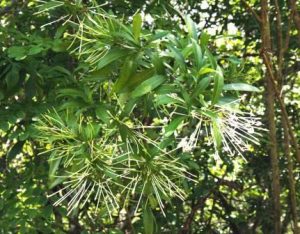
Ixora narcissodora flowers. Photo: Bart Wursten. Source: Flora of Zimbabwe
The white flowering Ixora narcissodora (odour like a narcissus) is found only near the Mtarazi Falls in the Hondi Valley. There is also an orange flowering Ixora which can be bought as a horticultural specimen, but this hybrid originates from West Africa. If I may be excused a bit of botanical rambling, we note the five petals of the tube like flower are fused together which is considered to be an ‘advanced’ feature and that is why the RUBIACEAE are right at the back of most botanical books just before the COMPOSITAE. Flowers with separate petals, like the rose family, ROSACEAE, are in the middle and flowers that have no petals, like mulberries, MORACEAE, and willows, SALICACEAE, are at the front of the Dicotyledons which are all plants with net veined leaves. Another so called ‘advanced’ feature of the RUBIACEAE is the inferior ovary, where the fruit is underneath the flower and not enclosed by the petals as in a pea, LEGUMINOSAE family. The remains of the dried flowers is often seen on the end of the fruit, we saw this ‘persistent calyx’ in at least 5 RUBIACEAE species on this particular walk.
We made our way carefully through the forest section with our youngest member’s pram to see a large leaved tree very like the mahobohobo, Uapaca kirkiana, the Gardenia imperialis. And a very royal flower it is too, with large flowers almost a foot long, that one hardly sees in the tall forest canopy. This tree is found in the Burma Valley along the side streams on the eastern part of the Vumba. The slow growing tree has stipules that almost surround the branch. Gardenia and Rothmannia are rather similar, the fruit of both take a long time to ripen and as we saw mostly on the G. posoquerioides we also noticed the characteristic pattern of leaves in threes. Here we were able to see the tubular creamy flowers of Gardenia, a slender flower compared to the bell like Rothmannia. The fruit of G. posoquerioides is ribbed and elongated with the persistent calyx on the end. The interpetiolar stipules surround the branch and look like webbing on the older branches.
Down in the lowveld there is one important RUBIACEAE tree, Crossopteryx febrifuga. This tree is found in the jesse, Mopani country, on the escarpment as well as in miombo woodland and on the Shamva kopjes but it is difficult to cultivate, especially when the nyangas and botanists attack the bark. When the bark is stripped, crystals appear on the inner surface which explains the common name “crystal bark”, but such damage will not be appreciated in the gardens! The petioles and branchlets have a reddish tinge and the small old fruit remains on the tree for a long time. We smelt the small honey scented flowers that occur in dense terminal heads.
Zimbabwe has only one species of Feretia, F. aeruginascens. The dark green leaves have a slight reddish tinge and a quilted appearance. The stipules are fairly woody. This is a scrambling riverine shrub from the Zambezi Valley although it can also be found on termitaria and in Mopani veld. At the distance the white flowers can be confused with those of Combretum mossambicense. The fruit has the persistent calyx and is attached to the woody branches.
Wandering over Tom’s newly planted grass in the rapidly darkening shade, we examined the large Rothmannia ursiliformes. The unripe fruit of this species is sticky and a devil to get off ones’ hands and mouth. Once again we noticed the leaves in threes. R. ursiliformis is found at medium height in the Vumba and Mt. Selinda areas where it is easily mistaken for another RUBIACEAE, Aulacocalyx deirvilleoides that also has leaves in threes and both species have a speckled slash. Moving on to this Aulacocalyx we were able to see the important differentiating feature, the red flush of the thin new leaves. While in the forest we saw the forest wild medlar, Vangueria esculenta with the decussate branching and flat plain of the leaves. Yet another inhabitant from the Vumba/Mt. Selinda region.
I had thought Pavetta was the only RUBIACEAE with bacterial nodules but some Psychotria species also have them. The specimen we examined Psychotria zambamontana, which is one of the most common shrubs in the high altitude forests at Inyanga, lacked bacterial dots. The leaves are rippled with more than ten pairs of lateral veins. Below room P. zombamontana is replaced in the understory by the larger leaved P. mohonii. We saw this tree tucked away in the forest behind the climbing Canthium lenricianum. The seedlings of P. mahonii were originally mistaken for Gardenia imperialis. The shiny leaves are wrinkled and have a quilted look with less than 10 pairs of lateral veins. As an interesting sideline we backtracked to examine three plant species, each from different families but all had almost identical appearance due to their common lifestyle. The dwarf Psychotria (RUBIACEAE), a type of wandering jew (COMMELINACEAE) and a grass (POACEAE) all live on the forest floor and are so alike as to be glossed over as identical.
We examined two of the three indigenous species of coffee, Coffea ligustroides is a slow growing shrub with long interpetiolar stipules and small thin leaves. The real coffee Coffea zanguebarica has bigger leaves. For a long time it was thought that botanist Swynnerton had been mistaken in having reported this species from Zimbabwe until it was rediscovered occurring as a common understory plant in patches along the Rusitu river.
It was well overtime when we examined Aidia micrantha right next to the Psychotria mahonii. Aidia is common near the Pungwe bridge in the Honde Valley where pure stands of Newtonia and Aidia exist. The orange beans on the tree looked very similar to commercial coffee beans but the leaves resembled Canathium and Psychotria. The leaves are puckered with a sinuous as opposed to a quilted look..
Thank you Tom, we really did get into the RUBIACEAE and look forward keenly to the next installment of the same family. The RUBIACEAE are well known worldwide for often having a symbiotic relationship with ants, known as myrmecophily. If anyone is aware of such a relationship locally we would be very keen to hear about it.
-Kim St.J. Damstra
VISIT TO MARSALA FARM, SHAMVA, SUNDAY 20TH MARCH
An unseasonably hot March Sunday made some of the more temperature sensitive of us a bit apprehensive as Shamva was bound to be hotter. It was, but the interest of the area took most minds of the perspiration. Shamva district is a mix of high and lowveld species, and Marsala farm had several different habitats in store for us.
From the bus we walked across a fairly open area with a great deal of coppice growth. This was due mainly to fire, and those species in this area were obviously fire resistant as there we signs of charring for more than 2 meters up the trunks. Most conspicuous were the mahobohobos or muzhanjes, Uapaca kirkiana, the very corky bark still intact despite the scorch marks. It is some time since we have come across the other species U. nitida but it bears such a strong general resemblance to mahobohobo despite the much smaller shinier leaves that we recognized it at once. The real clinching shared character is the growing point. The new leaf comes out bronze coloured and looks very soft. However it is hard to the touch, actually feeling dry and dead – which it is not. Uapaca belongs to the family EUPHORBIACEAE and male and female flowers are borne on different trees. One often hears people remark that “the mahobohobo in the garden has never borne fruit” and the reason of course is that it is a male tree. U. kirkiana is very frost sensitive and one will often find them on some slope of a hill but not another for this reason.
It was a day of comparisons because there seemed to be examples of a variety of species which we tend to confuse.
First of these was Swartzia-Pericopsis, Swartzia madagascariensis (which to illustrate the usefulness of scientific names does not occur in Madagascar) is the ‘snakebean’ which we usually see adorned in the long wavy pods which give it the common name. However those we saw this day had no pods, and for once we were forced to look further for clues to identity. It immediately struck us that the leaf was similar to that of Pericopsis angolensis (‘Afromosia’ or ‘Muwanga’). There was the same general arrangement of leaflets in the compound leaf, with the same bigger terminal leaflet set off at an angle to the radius. Of course the bark is the ultimate distinction, ‘muwanga’ has a smooth whitish bark and ‘snakebean’ a rough fissured one. However, if presented with a leaf alone, Swartzia has velvety yellowish hairs on the underside of leaflets and rachis, Pericopsis is smooth and glabrous.
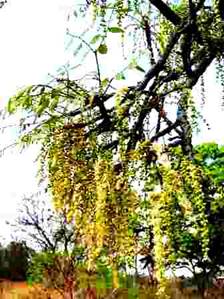
Burkea africana flowering. Photo: Mark Hyde. Source: Flora of Zimbabwe
Moving on we discovered Burkea africana. Although it is sub family CAESALPINIACEAE, and Albizia antunesiana is in MIMOSOIDEAE, they are seldom seen in flower and are relatively easy to confuse. Both are bipinnate, and the leaflets themselves look alike. However, Burkea is unmistakable when one looks at the growing tip. It is always covered in short, dense reddish or copper coloured hairs, resembling velvet. A. antunesiana lacks this velvet, and has in addition a large gland at the base of the petiole.
Flacourtia indica was everywhere, but here our comparisons were restricted to many different specimens of the same thing. We find it one of the most variable species, even in the same area.
Walking further, the habitat becomes more rocky and the burn damage was no longer seen. The first rocky outcrop was a wealth of different species; Allophylus africanus, Zanha Africana, Rhoicissus tridentata and the large ‘mystery tree’. Brian Best took a specimen in to the Herbarium, and it was, as suspected, Cassine transvaalensis. A short way further on brought us to a sudden steep descent which showed us that we were actually atop a kopje. Here we found Bequaertiodendron magalismontanum in the shade of huge mountain acacias, Brachystegia glaucescens, so typical of kopjes. Further excitement when we spotted Pittosporum viridiflorum. Although there was no fruit, the trees bore the characteristic to which Meg drew our attention, there are always some twisted and shriveled looking leaves near the ends of branches.
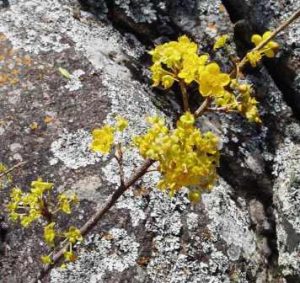
Ochna puberula flowers. Photo: Mark Hyde. Source: Flora of Zimbabwe
A further comparative exercise awaited us up there, then we discovered Ochna schweinfurthiana and Ochna puberula growing next to each other. The former is the larger leafed of the woodland species, and has very serrate leaves. The latter has much smaller leaves, and the serrations are comparatively minute. We failed to find O. pulchra, but it is distinguished by its small, almost entire margined leaves, and the conspicuously papery, peeling bark. Returning from the morning walk, we found Alex Dry contentedly in his chair, maintaining that the branches of four species of tree crossed above his head. He was severely criticized for maintaining one to be Parinari curatellifolia. It was pointed out that if he took the trouble to look he would observe the flower like fruit and the leaf gland characteristic of Monotes glaber, which is common in the area. And so he was wrong, but the rest of us were too, because, by comparison with the specimen next door it became obvious that we were looking at Monotes engleri, pink fruited monotes. The leaves do indeed bear a resemblance to those of Parinari; they are much darker and hardier looking than those of M. glaber and are markedly paler on the under surface. M. engleri is considered to be a tree of medium altitude and M. glaber of high and medium altitudes. However, we have seen both species, again growing side by side at Warren Park just outside Harare.
After lunch, the heat still unabated, we skirted round the area of the morning walk, and descended until we were at the base of the kopje on which we had stood in the morning. On the way down we came across Protea welwitschii covered with white sweet smelling flowers. PROTEACEAE was a family well represented on this walk. Apart from the above mentioned species with its thin hairy leaves, we saw G. gaguedi with its leaves of similar shape to those of P. welwitschii but without hairs, and also P. angolensis with its relatively broad hairless leaves. Seeing P. welwitschii in flower demonstrated a notable characteristic of this species; namely that the flowers occur in heads of 2 – 4 and not singly as in the other two mentioned species. The PROTEACEAE was a well represented family, as we also saw both species of woodland Faurea, namely F. saligna with its narrow leaves closely resembling gum leaves, and F. speciosa with its broad furry leaves. The key difference between this genus and Protea is that the Faureas have flowers in catkins, Protea has them in flattened heads.
Another family well represented was the STRYCHNACEAE. We saw S. cocculoides with its very corky bark; S. innocua with its powdery bark; S. potatorum, the ‘grape strychnos’, aptly named for its fruit and Strychnos spinosa, the spiny monkey orange. None had fruit.
Parallel to the base of the kopje ran a small stream, surprisingly still running well. There was no riverine gallery vegetation, but water berries, Syzygium cordatum, did occur all the way along, not in fruit unfortunately.
Of note in the area were the Elephantorrhiza goetzei in pod. The pods are very long, and the seeds are shed in a characteristic fashion, the rim of the pod remains hanging on the tree whilst the seeds drop one by one from the central point.
Also in heavy fruit were what we call ‘hockey sticks’, Indigofera rhynochocarpa.
It was a rich day species wise. We recorded 97 species of trees, and would no doubt have reached 100 if I had not ignored the odd ankle height Vernonia.
Brian Best collected a couple of annuals which proved quite interesting. One was Sesamum alatum “sesame” , not a common plant.
The attractive ‘peaflower’ that some of us admired was Tephrosia paniculata, also not a common plant, and more characteristic of lower altitudes.
MATABELELAND BRANCH
Due to the public holidays, there will be no outing this month.
-Phil Haxen Chairman


